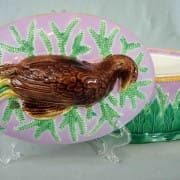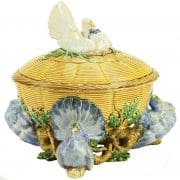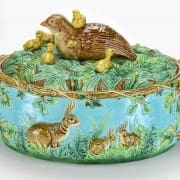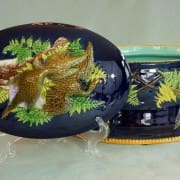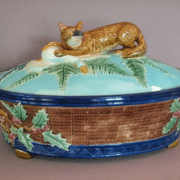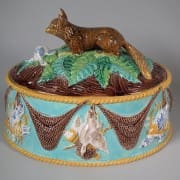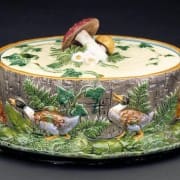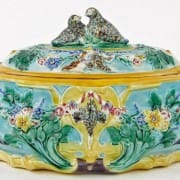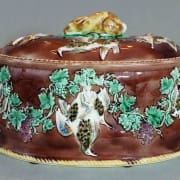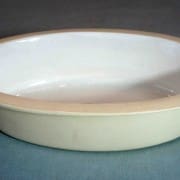Game Pie Dishes
A game pie is a savory pastry dish containing any of a variety of game meats. Meat pies were consumed by the aristocracy of the Roman Empire and included wild birds and other animals. Over time, the methods of preparation of game pies has evolved with technical advances and changes in culture. It was during the Victorian Era that the preparation and serving of game pies reached its most elaborate level.
In the Middle Ages, game pies were prepared within a tough hot water crust that served as the cooking vessel for the pie. The sides of the crust, or “coffin” were prepared by hand and the process was known as “raising the coffin”. After adding the game meats, spices and fruits, a pastry lid was fashioned and the contents sealed inside for baking. Large or small birds were often placed on top of the pie for presentation at a feast.
The hard crust was typically inedible and was discarded. During the 18th century, the sprung metal pie form came into use. These molds allowed the use of a finer pastry than the hot water crust and the edible pastry could have an elaborately decorated surface.
By the latter half of the 18th century, innovations in ceramic manufacturing allowed the mass production of glazed pottery dishes which could withstand oven temperatures. At the suggestion of Richard Lovell Edgeworth in 1786, Josiah Wedgwood began producing covered pottery game pie dishes with an interior liner which held the pie for baking. The traditional pastry coffin was no longer needed. This innovation proved useful during the 19th century when wheat flour was scarce in Britain due to reduced domestic agricultural production and trade restrictions imposed by the Napoleonic Wars. Some of the earliest examples of game pie dishes were produced in unglazed caneware which resembled a decorated hand raised pie crust.
During the Victorian Era, majolica game pie dishes became more popular. The pie was baked in the ovenproof liner and delivered to the table in an elaborate, brilliantly glazed covered majolica dish.
Game was considered a great delicacy in Victorian times. Previously, only the aristocracy and gentry had access to hunting lands. Hares, partridges, geese, pheasants, pigeons and grouse remained coveted treats. An opulent Victorian dinner party might have included a variety of game entrees including a game pie.
The presence of a game pie at a dinner party was evidence that an aspiring middle-class family had either the wealth or connections to acquire game legally. A finely modeled majolica game pie dish would satisfy the host and hostess that their guests noted its presentation at the dinner table.
Most of the major majolica manufacturers produced game pie dishes. The common motifs centered on game animals and hunting themes. All examples consist of a tureen base with an elaborately modeled cover. The outside of the tureen is frequently decorated in relief with game animals and foliage. The cover often features an intricately detailed larger animal figure which serves as the handle. The interior of the tureen has an integral rim which supports the ovenproof liner. Few of the dishes have survived with the interior insert intact.
Minton produced several majolica game pie dishes. One rare model features two hares and two mallards on a cobalt blue cover, the ears of the hares joining to form the handle. Another is composed of a tree trunk with mushroom finial surrounded by ducks who are espied by predatory foxes. A finely modeled dish of similar design was produced by German potter Hugo Lonitz. The handle of the lid is either of a frog or stag rather than the mushroom of the Minton version. George Jones produced several highly prized game pie dishes. Particularly important is a model with rabbits molded in relief around the base and the cover decorated with a nesting pheasant which forms the handle. The piece was produced both with and without a brood of yellow chicks surrounding the hen. Models decorated with a boar’s head and another with a recumbent fox are also popular among majolica collectors.
Video: Victorian hand-raised game pie
Photo Credits: Strawser Auctions Live Auctioneers Ebay images Madelena Antiques Antiques from Trilogy Philppe Meunier & Juan-Alonso Defrocourt Karmason Library







